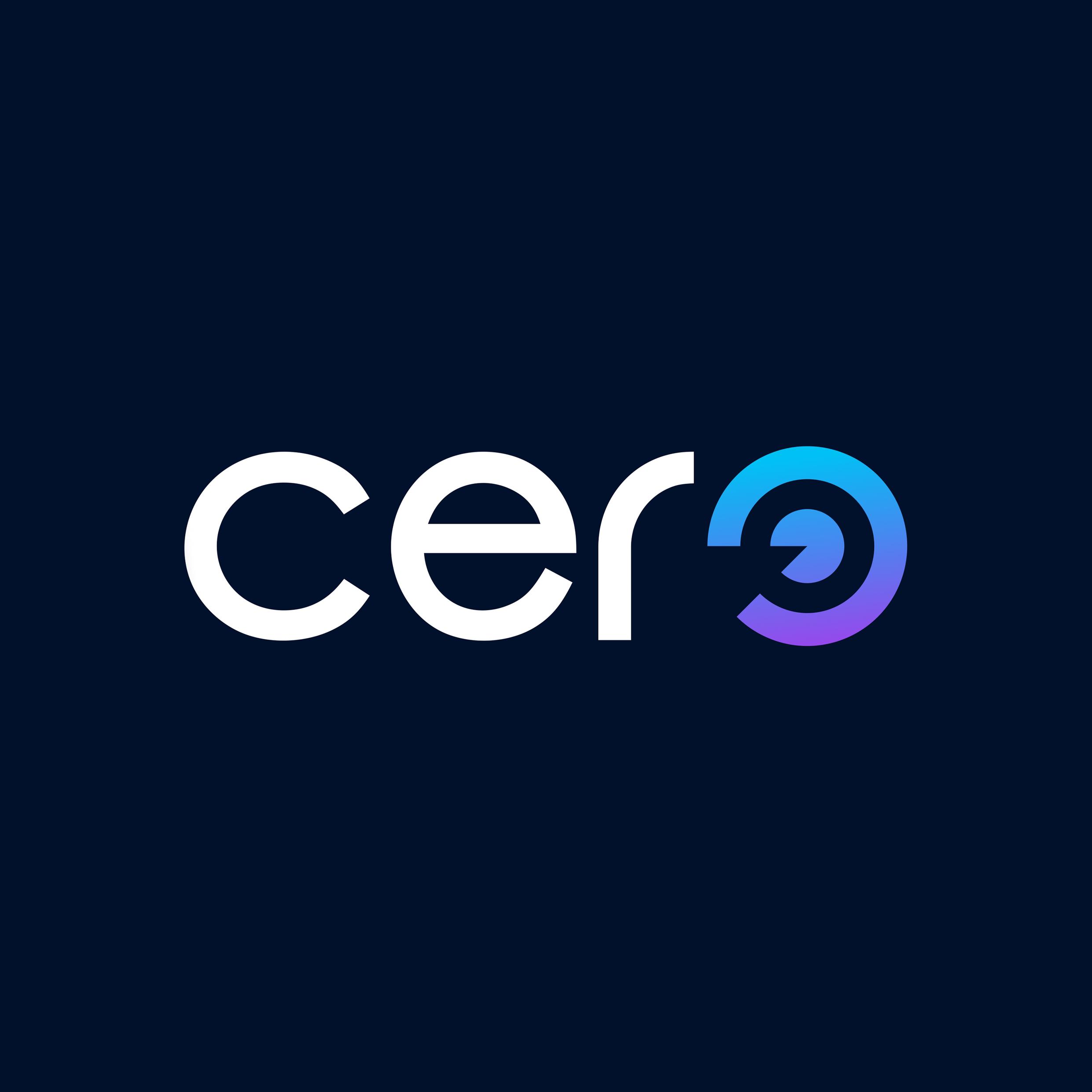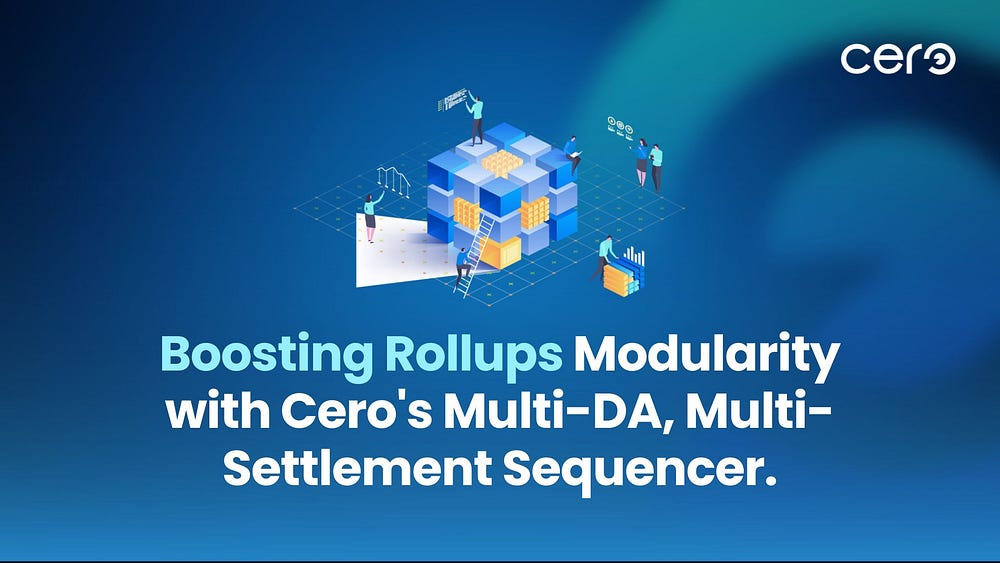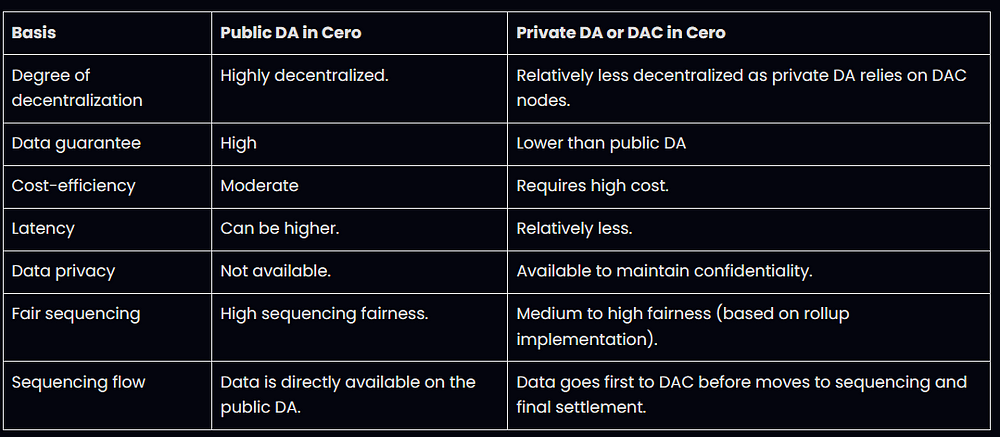How Cero’s Multi-DA, Multi-Settlement Sequencer boost rollup modularity?
 Cero Network
Cero Network
When considering the modularity in rollups, it is important to highlight the integral role of sequencers, especially decentralized ones. If you’ve read our previous article on Cero, you must now have a firm understanding of how a hybrid decentralized sequencer is a game-changing innovation in the blockchain space. Now, for this article, we will discuss the two important feature aspects of Cero: multi-DA and multi-settlement options that are designed to make rollups truly modular for more flexibility and higher performance.
A quick rewind of Cero’s Hybrid Sequencing Network
Cero is a decentralized hybrid sequencing network designed to eliminate all the challenges of centralized sequencing while enabling modularity and high level of security in all kinds of rollups–be it optimistic or zero knowledge. The reason why Cero is called hybrid is due to its provision to allow rollups to opt for shared or dedicated sequencing within a single sequencer network. Below are some of the Cero’s features that makes it a unique, ideal choice for sequencing in modular rollups:
Custom staking: Rollups using Cero can perform staking with Cero’s token, or they can use their own native token for this purpose. This means, rollups can implement a custom tokenomics as per their specific validator requirements.
Data privacy: Rollups can enable data privacy and accessibility parameters in their ecosystem, and meanwhile they can benefit from the decentralization and security of Layer1.
Dedicated sequencing: Rollups can opt for dedicated sequencing to avoid sharing the sequencer with any other chains and hence attaining greater performance.
Multi-settlement layer: Rollups can choose any Cero-supported chain to utilize for Layer1 settlement.
Multi- DA Layer: Cero offers support to multiple DA layers– both public and private to be used for data availability.
Delving into Multi data availability (DA) and Multi-settlement feature of Cero
As discussed, Cero sequencer is designed in a modular fashion. Hence, it strives to add modularity in rollups, mainly for components that require extensibility the most, such as the data availability and settlement modules. Let’s dive deeper into these multi data availability (DA) and multi-settlement options to better understand their usefulness:
- Multi data availability (DA) Layer configurability:
Right now, various alternative data availability layers are available for rollups to use, and they are being rapidly adopted due to factors such as excellent data guarantee, greater throughput, low gas fee, and a range of other innovative features. Having understood the significance of alt DAs, Cero provides rollups the choice to use either Layer1 like Ethereum as their data availability layer or they can integrate external public DAs like Celestia and Near DA. That’s because Cero understands that while Ethereum leads in terms of security and ecosystem maturity, alt public DAs are good for scalability & customization.
That was about the rollups that need public DAs, but what the rollup wanting to keep its data confidential? Cero addresses this concern by extending its multi-data availability option to private data storage systems based on data availability committees (DAC) or validium where data is stored and processed off-chain. This configurability option is suited for enterprises and web3 projects that deal with sensitive data and hence do not want to make it public, however they still want to leverage all the benefits of settling on the main Layer1 chain.
All these flexibility aspects makes Cero a preferred decentralized sequencer for all types of rollups, whether its public or permissioned. Also, below is a quick comparison of Cero’s public DA and Private DA that will make this whole Multi data availability (DA) concept even more clear.
BasisPublic DA in CeroPrivate DA or DAC in CeroDegree of decentralizationHighly decentralized.Relatively less decentralized as private DA relies on DAC nodes.Data guaranteeHighLower than public DACost-efficiencyModerateRequires high cost.LatencyCan be higher.Relatively less.Data privacyNot available.Available to maintain confidentiality.Fair sequencingHigh sequencing fairness.Medium to high fairness (based on rollup implementation).Sequencing flowData is directly available on the public DA.Data goes first to DAC before moves to sequencing and final settlement.

- Multi-settlement Layers configurability:
Similar to data availability, rollups may also seek to use a particular settlement layer. Cero’s chain-agnostic, heterogeneous architecture makes it a novel multi-settlement decentralized hybrid sequencer. This allows rollups to pick a particular blockchain to use for settlement based on their ecosystem–related needs. Rollups can make the selection at the time of their registration on Cero.
As you may already know, the settlement layer in rollups is responsible for settling transactions as well as interactive proofs. Meanwhile, it also accommodates the bridging and liquidity requirements across chains. Each settlement layer (blockchains) comes with its own benefits, for example- some are optimized for cost-effectiveness, or high scalability, or seamless cross-rollup/Layer1 interoperability to attain unified liquidity. Additionally, some rollups want to use layer2s as their settlement layers so that they could be running a Layer3 on top of Layer2. While the requirements can differ, every modular rollup seeks the one main thing, which is fair sequencing.
With Cero, fair sequencing is enabled on all the following settlement chains. Rollups can choose whichever is feasible for them:
Ethereum
zkSync Era
Polygon PoS
Arbitrum
Also, Cero plans to expand this list of settlement layers with leading blockchains like Polkadot, Optimism, Avalanche, Arbitrum Nova, and few more. Cero has enabled integration of multi-settlement layers, a simplified process with its flexible architecture and soon to be enabled; plugin based integration.
How will this boost modularity in Layer2/layer3 rollups?
Modularity in any rollup refers to its ability to outsource the network’s components like data availability, consensus, or the settlement layer. Cero sequencer enables such modularity in Layer2/Layer3 rollups by providing them the flexibility and efficiency in choosing multi-DA layers and settlement layers for their ecosystem. By integrating a suitable DA or settlement layer, rollups cater to its diverse needs and meanwhile make the whole network operations more simple and manageable. Note that integrating alternative components may require a complex integration approach. However, to compensate for this, modular sequencers offer higher scalability and efficiency with several other benefits.
Wrapping up!
For decentralized sequencers, the modular approach has proved to be a more viable option as more rollups nowadays are prioritizing modularity. Cero utilizes this opportunity by offering multi-DA and multi-sequencer options on its decentralized sequencing network, thereby bolstering rollups modularity. However, rollups on Cero can also proceed with the standard configurations, including for DA and settlement layer. Cero can be a good choice for you if you want to leverage reliable, new-age decentralized sequencer in your rollups, Cero can be a good choice for you. For more information about Cero or any queries, you can schedule a call with our rollups & appchain experts. Or else, mail us all your concerns.
Subscribe to my newsletter
Read articles from Cero Network directly inside your inbox. Subscribe to the newsletter, and don't miss out.
Written by

Cero Network
Cero Network
Cero Network is the first Universal transaction layer based on decentralized sequencing with an option for shared and dedicated hybrid sequencing models for L2/L3 rollups.